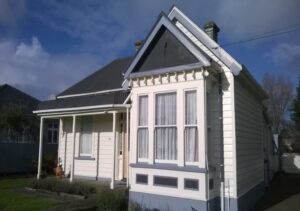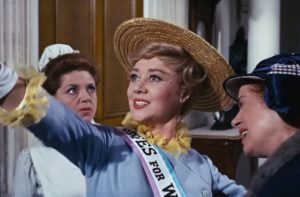1890s: The Villa
June 25, 2024
By AHNZ

Kiwis have a love/hate relationship with a form of domestic architecture called the Bay Villa or just Villa (for short.) Many of the homes in the New Zealand’s housing stock still date from this Victorian/Edwardian period between about 1890 and 1918. In the South Island, particularly Christchurch, straight-shooting real estate dealers called these a T House due to their typical floor plan. Aucklanders, applying a bit of razzle-dazzle to help them sell, and being more pretentious, won the day with their name ‘villa’ which is now the vernacular term.
A villa’s chief characteristic is that its locus of utility is directed toward the population rather than those whose home it is. It seeks to impress even to the extend of placing its support rooms (eg laundry, bathroom) into the day’s sun and its chief rooms (living room, bedrooms) in the shade. The custom of having a “Front Room” with the best furniture and decoration which was hardly ever to be used betrays in its name that it was not situated according according to the natural environment but rather toward the social environment. The villa was built to privilege the man in the street rather than to serve those who had to live within.
As a result of this orientation they tend to have impressive, even ostentatious, facades facing the street while the unobserved other sides are left bland. Some of these had very elaborate ornamental verge boards with gingerbread trim decoration and even fancy wood-turned finials extending into the sky like grander counterparts on some great castle estate or church. The front doors also aimed to be extra in accommodating sidelight windows flanking them above and to the side; A real signal of show.
We are used to our shops having false-fronts these days. Instead of buying in bulk we pay more for flash packaging. Much of the price we pay for goods and services goes into paying for the advertising budget to get us to pay for the goods and services (as of about the 1960s.) The villa applied this false-frontage idea to the domestic situation.
Architects self-identify by their strong distaste for the villa. Garrett (1966) called them “The Late Victorian Problem.” Pascoe (1940) accused them of being haphazard, mediocre, self-conscious, confused. Where to live in Auckland says their hallways are a cold conduit in winter and a dust conduit in summer. Topping that, Cooke (quoted by Litterick (2016)) didn’t call them villas but named them “centre gutter” type houses after that characteristic center hallway. Cresswell (2015) says they’re bastard prisons that ought to be demolished and harvested for their native timers! Owtch.
“From the nineties to the Great War, domestic architecture entered a haphazard stage of evolution…building became increasingly self-conscious. Of the many types of smaller house built in this period the ‘T’ best reflects these tendencies…a veranda, ornamented by iron work and some coloured glazing, and a roof gable with molded woodwork which overhung a bay window…they face with their important rooms to the street regardless of where the summer aspect might be…mediocre designs…undesirable influences…a confused idea that design in order to be good must be imposing and ornate.” – MNZ (1940)
“In nineteenth century England, the growing middle class wished to distance themselves from the rural peasantry and industrial working-class, and what better way to do so than to emulate those rich men in their country houses, albeit on a smaller scale? Of course, the average doctor or company director could not hope to have the rolling acres of the landed gentry, but they could at least show that they did not need to make use of what land they did have and could simply use it for show. So it was that the lawn in the back garden was born. It symbolised the grounds of a manor house.” – Webb (2024)
“A villa is outside-in; a bungalow is inside-outward.”“A villa’s verandah is for show; a bungalows decks, porches and terraces are to be used.”“A villa is intended to impress passersby, a bungalow to please its occupants.” – A villa is not a bungalow, Not PC (2015)“…featured broken “picturesque” roofs, strident “marseilles” tiles, slates, fussy terracotta ridges and finial decorations, elaborate false gables, with curved ribbed metal eaves, and course brackets over bulbous bay windows. Expressive of the Art Nouveau was the fretted wood ornament on verandahs, halls, and furniture, matched by leaded casement fanlights and doors. The typical house had projected “feature” rooms front and side, with narrow timber verandah between. With its irregular outline, aimless contrasts, incomprehensive ornament, without order, proportion, harmony, or unity,…” – The Late Victorian Problem: 1890–1918, Garrett (1966)
“Several nineteenth-century architects described the villa as an intermediate dwelling type between the mansion and the cottage,”- Archer, quoted in Litterick (2016)
“…the occupiers of villas “have more cultivation and taste” than others, particularly cottagers. From their wealth, they “have been able to command the services of all who possessed an ability to render them assistance” – Burlington, quoted in Litterick (2016)
“Villas were seen as architecturally inept and built like packing cases. The classic villa hallway was condemned as a conduit of cold air in the winter and dust in the summer.” – Where to live in Auckland (e2003)
“I was surprised, when I carried out my analysis of the relationship between different features on the exterior of house…and class of the builder that it was, of all things, sidelights that were most important. ” – On Halls, Katharine Watson, Christchurch Archaeology Project (2023)
 “If I had to say which was telling the truth about society, a speech by a Minister of Housing or the actual buildings put up in his time, I should believe the buildings,” said historian Kenneth Clark. The villa belonged to the era Edith Wharton ironically called ‘The Age of Innocence’ which she says died out with WW1. So, it also belonged to the Progressive Era of our great Wokesters and Liberal politics before it was disrupted by the Great Boogaloo of 1913. A time of conformity. An era of Virtue Signalling.
“If I had to say which was telling the truth about society, a speech by a Minister of Housing or the actual buildings put up in his time, I should believe the buildings,” said historian Kenneth Clark. The villa belonged to the era Edith Wharton ironically called ‘The Age of Innocence’ which she says died out with WW1. So, it also belonged to the Progressive Era of our great Wokesters and Liberal politics before it was disrupted by the Great Boogaloo of 1913. A time of conformity. An era of Virtue Signalling.
Think of the villa when you think of bourgeois women trying to signal their status. The same set that tried to force “Scientific Temperance Instruction” into the schools, “rational” dress reform, anti-smoking, anti-drinking, prisoners and prostitute philanthropy, women’s suffrage, and white feathers to shame men into war wanted houses to be like these.
We must remember that a villa situated in its own time period had points in its favor. They’re cold, damp, and expensively difficult to warm with our 2020s heat pumps and electric heaters that they were never designed for. But the villa was designed to be powered from within by a coal range that kept it warm and dry. Now banned technology in most parts of the country its absence leaves the villa a shell deprived of the animating soul. Occupants have forgotten it had such a thing and will wonder why their house feels unsettled. “The kitchen was to the New Zealand family what the command bridge is to an ocean-going ship, the range its engine.” Ref. 1873: I Am Iron Man, AHNZ
Villas were not designed to anticipate and annoy we modern New Zealanders but as a relief of the dreary past during a time of economic recovery. After the Gold Rush and the Maori Wars a new, fairly ignorant, generation tried to “fix” their recession by blowing huge amounts of borrowed money. The Vogel Boomer Generation were like their future generational counterparts the Baby Boomers in this way and take their name from Prime Minister Julius Vogel who was chief architect of the resulting Long Depression. When at last these bad times ended and Vogel had gone away we wanted to expel the bleak times lived in dreary old cottages.
As productive people who could afford to build new houses in the recovering economy gathered pace they built villas. These were a great step up from the aging colonial cottages that had kept body and soul together, tolerating deferred maintenance, throughout the big slump. It was like going from muddy streets to concrete which seemed to those who had done it a great step up. However as James K Baxter observed those who inherat a “concrete playground” and never knew mud will think their ancestors artificial and alienated from nature. The villa makes much more sense if we can empathise with the Long Depression era they were the ointment for.
Later, when Napier was being re-built after the Hawke’s Bay Earthquake (1931) folks made a point of being seen and heard to re-build. Instead of welding, as was the norm they even used rivets. “It would be louder, a statement. The whole city would know that the rebuild had begun.” Ref. Guardian (2016) And, Napier was re-built in a stand-out new modern style. I think the villa was a whole-New Zealand response to a disaster but in this case the earthquake was economic. The houses are a self-conscious signal to others rather than an individualistic ego expression of self-esteem but maybe they thought the key thing was to build up the national ego and economic recovery? During the 2020s COVID Panic we did a similar thing with stuffed animals. They weren’t inside houses facing the inmates but at the windows facing those without and trying to transmit encouragement and support.
Simon Webb (2024) offered a good explanation as to why we Anglos appreciate back gardens where other peoples do not. They’re scaled down, affordable, version of the estate grounds enjoyed by the gentry. The Middle Class Anglo has back/front lawns and decorative gardens after the example set by the Upper Class. In the same way, those with money make golf their leisure while those who are low-budget play mini-golf. A hard-working professional can’t build himself a Pah Homestead (1879) or Edmonds Factory Gardens (1923) but everyone could aspire to have their own little microcosmic 1/4 acre paradise version in the suburbs.
—
Image ref. Invercargill villa, AHNZ (2018)
Image ref. Cox photo of a villa, Auckland Libraries Heritage Images Collection
Ref. Why some foreigners in Britain build over back gardens, poach fish, kill swans and engage in fly-tipping on an industrial scale in beauty spots, Simon Webb, Substack (2024)
Ref. Encyclopaedia of New Zealand, James Garrett, A. H. McLintock (1966)
Ref. The Lost Bungalow and Other Stories, University of Auckland thesis, Paul Litterick (2016)
Ref. Houses, Paul Pascoe, XX Making New Zealand (MNZ) (1940)
 Like Comment Share
Like Comment Share





